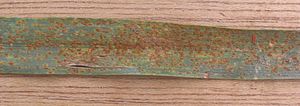Pycniospores are a type of spore found in certain species of rust fungi. They are produced in special cup-like structures called pycnia or pynidia. Almost...
2 KB (195 words) - 09:32, 30 October 2023
Basidiospore/Basidium/Teliospore anamorph/asexual: Sporangium Conidium Chlamydospore Oidium Pycniospore Other Hypha Haustorium Mycelium Cell wall Sporocarp...
48 KB (5,062 words) - 02:49, 27 June 2024
are generally dark brown. Fungi portal Chlamydospore Urediniomycetes Pycniospore Aeciospore Teliospore Ustilaginomycetes Rust fungus: Spores C.J. Alexopolous...
3 KB (93 words) - 20:42, 20 October 2023
basidium with haploid basidiospores. Fungi portal Aeciospore Chlamydospore Pycniospore Rust fungus § Spores Urediniomycetes Urediniospore Ustilaginomycetes...
2 KB (189 words) - 20:03, 7 January 2024
and pycniospores. These lesions will produce a sticky honeydew like substance to attract insects that assist in the transport of the pycniospores to different...
14 KB (1,599 words) - 15:56, 1 May 2024
insect pollination in flowering plants. Fungal spermatia (also called pycniospores, especially in the Uredinales) may be confused with conidia. Conidia...
30 KB (3,401 words) - 06:05, 28 May 2024
the pycniospores and the receptive hyphae. The pycniospores are produced in a sticky honeydew that attracts insects. The insects carry pycniospores from...
67 KB (7,255 words) - 06:18, 27 August 2024
have traditionally been used to refer to these morphological types. 0-Pycniospores (Spermatia) from Pycnidia. These serve mainly as haploid gametes in heterothallic...
30 KB (3,320 words) - 17:36, 16 August 2024
After winter there are two spore types that are formed pycniospores and ascospores. The pycniospores come from conidia and the ascospores come from the perithecia...
10 KB (1,136 words) - 04:33, 19 April 2024
Urediniospores, teliospores, and basidiospores develop on wheat plants and pycniospores and aeciospores develop on the alternate hosts. The germination process...
22 KB (2,561 words) - 06:35, 7 July 2024
classified as a Phoma species on the basis of its similar production of pycniospores to other species of Phoma and the species was re-named Phoma glycinicola...
6 KB (554 words) - 14:30, 19 January 2024
stages in P. sorghi. The spore types are teliospores, basidiospores, pycniospores, aeciospores, and urediniospores. Every year, viable urediniospores must...
6 KB (751 words) - 05:12, 20 May 2024
spermagonia; syn. pycnium for rust fungi) spermatium (pl. spermatia; syn. pycniospore for rust fungi) spicule spiroplasma – helical, motile, cell wall-less...
55 KB (1,972 words) - 13:37, 25 June 2024
Aecium are then formed from the pycnium after being fertilized with a pycniospore that is of a different mating type. Urediniospores and aeciospores then...
7 KB (752 words) - 23:00, 8 March 2024
in Iceland, where it infects Taraxacum species and Carex capillaris. Pycniospores and aeciospores are found on Taraxacum sp., and uredospores and teliospores...
2 KB (95 words) - 06:30, 14 May 2024
as receptive hyphae are formed. From here, nothing happens until the pycniospores produced by the pycnia fertilize receptive hyphae of a different mating...
7 KB (824 words) - 17:54, 10 January 2024
the pycnidia are branched and unbranched conidiophores with two-celled pycniospores, which later are ejected from the pycnidial ostiole. Additionally, the...
8 KB (846 words) - 04:49, 19 April 2024
climates such as the Mediterranean, Black Sea and Asia Minor. It forms pycniospores that are carried short distances by rain, or by wind to new leaves, where...
1 KB (82 words) - 20:36, 13 January 2024
is an autoecious fungus, meaning that all stages of its life cycle – pycniospores, aeciospores, and teliospores – all develop upon the same host plant...
19 KB (2,174 words) - 20:56, 9 April 2024
basidiospores of two mating types, types (+) and (-) are formed. Next haploid pycniospores are exchanged between pycnidia of different mating types on the upper...
7 KB (788 words) - 05:03, 10 January 2024
different spore stages and can get quite complex. These stages are: Stage 0: Pycniospores Stage I: Aeciospores Stage II: Urediniospores Stage III: Teliospores...
3 KB (349 words) - 18:10, 6 February 2023
teliospores, basidiospores, and urediniospores on cereal hosts, and pycniospores and aeciospores on the alternative plant hosts. These fungi are endoparasites...
13 KB (853 words) - 02:46, 1 May 2024
usually are 25–35 × 20–25 μm in size. The second stage involves yellowish pycniospores that form 0.1 millimetres (0.0039 in) structures around the aeciaspores...
6 KB (622 words) - 00:24, 19 May 2024


















